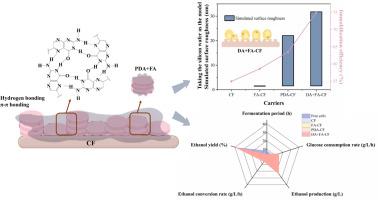Facile co-deposition of folic acid and polydopamine: Regulation of surface roughness on yeast adhesion in the continuous fermentation
IF 6.3
3区 工程技术
Q1 ENGINEERING, CHEMICAL
Journal of the Taiwan Institute of Chemical Engineers
Pub Date : 2025-09-25
DOI:10.1016/j.jtice.2025.106425
引用次数: 0
Abstract
Background
Adhesion is the basis of the cell immobilization, with the surface roughness being a critical factor in promoting the cell initial adhesion and biofilm formation. This study presented a versatile co-deposition approach that combined folic acid (FA) and dopamine (DA) for generating the rough surface.
Methods
Inspired by DA self-polymerization, a rough hierarchical structure incorporated with FA was constructed on the surface of cotton fibers (CF) through π-π interactions and hydrogen bonds (DA+FA-CF). Various modification parameters were investigated to explore the effect of the surface roughness on cell adhesion, biofilm formation, and continuous fermentation of Saccharomyces cerevisiae.
Significant Findings
The optimal FA concentration, modification time and deposition time (0.5 g/L, 6 h and 8 h) yielded the highest surface roughness, which significantly increased the immobilization efficiency from 54.92 % to 74.91 %, and the biomass from 5.95 g/L to 8.70 g/L, respectively. Moreover, DA+FA-CF reduced the fermentation period by 66.67 % and achieved an ethanol yield of 39.67 %, with a peak production of 23.75 g/L in the fifth-batch of continuous fermentation. This strategy offered a facile and biocompatible approach to improving continuous fermentation performance through surface roughness-regulated cell immobilization.

叶酸和多多巴胺的易溶共沉积:连续发酵中表面粗糙度对酵母粘附的调节
黏附是细胞固定化的基础,表面粗糙度是促进细胞初始黏附和生物膜形成的关键因素。本研究提出了一种复合叶酸(FA)和多巴胺(DA)生成粗糙表面的通用共沉积方法。方法以DA自聚合为启发,通过π-π相互作用和氢键(DA+FA-CF)在棉纤维(CF)表面构建了含有FA的粗糙层次结构。研究了不同改性参数对酵母表面粗糙度对酵母细胞粘附、生物膜形成及连续发酵的影响。结果最佳FA浓度、改性时间和沉积时间(0.5 g/L、6 h和8 h)可获得最高的表面粗糙度,使固定化效率从54.92%提高到74.91%,生物量从5.95 g/L提高到8.70 g/L。DA+FA-CF使发酵周期缩短了66.67%,乙醇产率达到39.67%,连续发酵第5批时产量最高达到23.75 g/L。该策略提供了一种简单和生物相容性的方法,通过表面粗糙度调节细胞固定化来提高连续发酵性能。
本文章由计算机程序翻译,如有差异,请以英文原文为准。
求助全文
约1分钟内获得全文
求助全文
来源期刊
CiteScore
9.10
自引率
14.00%
发文量
362
审稿时长
35 days
期刊介绍:
Journal of the Taiwan Institute of Chemical Engineers (formerly known as Journal of the Chinese Institute of Chemical Engineers) publishes original works, from fundamental principles to practical applications, in the broad field of chemical engineering with special focus on three aspects: Chemical and Biomolecular Science and Technology, Energy and Environmental Science and Technology, and Materials Science and Technology. Authors should choose for their manuscript an appropriate aspect section and a few related classifications when submitting to the journal online.

 求助内容:
求助内容: 应助结果提醒方式:
应助结果提醒方式:


